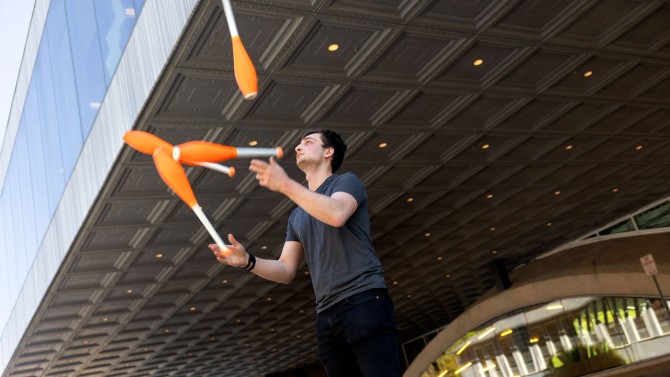Outside Gates Hall as spring classes ended, Jonah Botvinick-Greenhouse juggled a flurry of white balls - five, if you could keep track - hands occasionally crisscrossing, at times juggling entirely behind his back or above his head. Suddenly launching several balls skyward, the doctoral student in applied math pirouetted twice before calmly receiving the plummeting projectiles and lofting them back to lower altitudes.
"Wow," said a passing student, taking out a phone to record the scene. "Cool," remarked another. "That's dope," agreed a third, pausing mid-jog. Others wandered by, too distracted to notice one of the world's best jugglers at work.
After taking up juggling at age 10, Jonah Botvinick-Greenhouse won the World Juggling Federation's junior title at 12 - two years before becoming the youngest to win its advanced overall championship. Said WJF President Jason Garfield: "His patterns, his control, his symmetry and his accuracy I think are unparalleled."
On June 30, Botvinick-Greenhouse, a two-time winner of the World Juggling Federation's Advanced Overall Championship, will compete in Paris for the WJF's first Ultimate Overall Championship, pitting him against three other past champions from the U.S., Germany and Norway.
The Paris Olympic Committee invited the WJF to host the competition and an annual convention as part of pre-Summer Games festivities - a platform the WJF is using to build a case for juggling as an Olympic sport. Federation President Jason Garfield said Botvinick-Greenhouse, who holds a host of world records (here's one), has a shot to take gold in the event featuring routines with balls, rings and clubs, which ESPN will broadcast on Aug. 2.
"His patterns, his control, his symmetry and his accuracy I think are unparalleled," Garfield said. "Jonah's juggling is very aesthetically pleasing. It's rare, and I would say comforting, but also inspiring - and almost not believable, because it looks like it was programmed, like it's a simulation."
Perhaps that's appropriate for someone whose research in the Center for Applied Mathematics focuses on dynamical systems, and who as an undergraduate co-authored an article called "Juggling Dynamics" in Physics Today. Botvinick-Greenhouse, who earned math and physics degrees at Amherst College, not only takes pleasure in the act of juggling, but in the math underlying its patterns and the numerical notation system used to describe them, called "siteswap."
"It turns out there are a lot of exciting connections between mathematics and juggling, so many people who happen to like math will take to juggling pretty easily," he said. "It's kind of the go-to language for how jugglers talk to each other and communicate about the tricks that they're doing."
Earlier this year, he led a Math Explorers' Club workshop on the math of juggling that posed the questions: How are humans capable of performing juggling patterns that exceed the limits of standard reaction times? Why can four balls not be juggled in a crossing pattern? What kinds of mistakes in a juggling pattern will cause the juggler to drop?
It also introduced siteswap, a mathematical abstraction developed in the mid-1980s that counts the number of beats until an object is manipulated again - a number roughly corresponding to its throw height - and the order in which objects are swapped between hands. Thus, a standard three-ball cascade, among the first patterns learned, in which each ball is tossed every third throw, is denoted as "3" (or "333…"). Another common pattern, the three-ball shower, becomes "51" (or "515151…"): The right hand throws balls higher (5) to the left hand, which whips them back across to the right hand (1).
Jugglers can analyze siteswaps to determine if a pattern can be juggled. For example, since averaging a siteswap's digits reveals the number of objects being juggled, the average cannot be a fraction.







